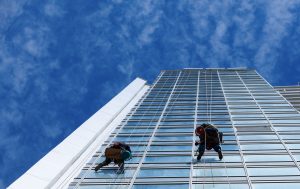Facade design is an important aspect of any building project, but that doesn't mean simply considering what the exterior of the finished building will look like.
Facade access design is an essential consideration. A good system will allow for maintenance to take place safely and at a reasonable cost. Maintenance operations can include setting up advertising, cleaning windows, fixing damage and more.
Here are five essential things you need to know about facade access design.
There are temporary solutions...
Temporary solutions for facade access include rope descent systems and hydraulic access platforms.
While these are relatively low-cost solutions, they have their drawbacks too. For example, a hydraulic lift will not reach the highest floors of a tall building, while rope descent work can take quite a long time.
... and permanent solutions
To secure a re-usable solution, a range of systems including monorail cradles or fixed davits might be favored depending on the jurisdiction (California, New York and other states have their own set of specific regulations).
Monorail cradles are useful on large flat or curved surfaces - they travel along a rail at the top of the building and can be lowered to the required level for access to the facade. They may not be appropriate to use for more 'experimental' facade designs.
For flat surfaces with less width, a fixed davit may be more cost-effective than a monorail cradle. Fixed davits are single arms which sit in one position and are used to raise and lower a maintenance platform.
Whichever of the two solutions you opt for, permanent or temporary, you will need to ensure that there is also a fall protection system to protect the people who are working on the facade.
Equipment needs to be inspected regularly
Just as facades need to be accessible, so does your facade access system so that it can be inspected and tested for safety at regular intervals.
OSHA 1910.66 states that all permanent equipment used to access a facade must be load tested when installed, and visually inspected every year. Additionally, OSHA 1910.27 states that each anchorages must be inspected annually and re-tested every 10 years.
Novel facade design calls for a novel approach
As modern architects create buildings with new and artistic facades, it's important to think about how the facade will be accessible for maintenance purposes.
Sometimes, this will require an approach which is slightly different from the norm. This must be considered at an early stage of the project.
If the architect's vision for facade design would result in a building which causes problems for facade access, there may have to be a compromise - or a novel approach.
It's always good to get a second opinion
Our facade access design consultancy services allow building owners and architects to take advantage of our expert knowledge to create facade access designs that are safe and cost-effective.
We provide turnkey structural design and engineering solutions for new buildings, and can also help retrofit existing buildings to bring them up to code. Contact Us today to find out how we can help with your façade access project.









